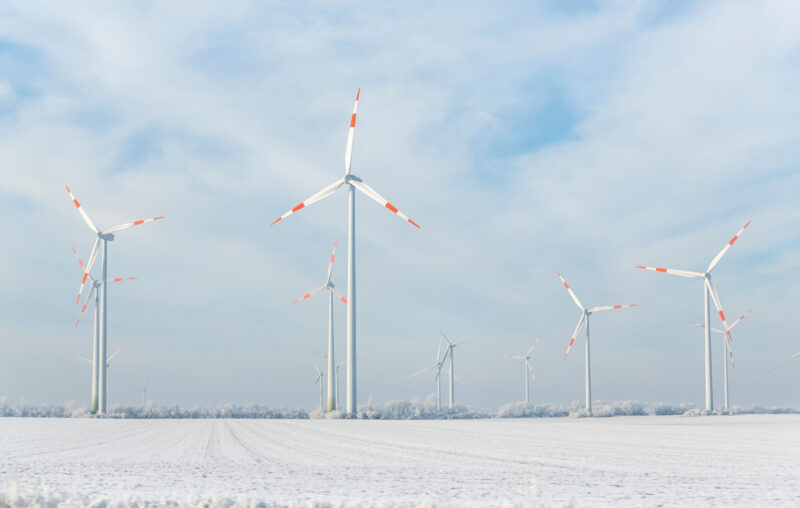
Greta Thunberg is back in the news. This time, she’s protesting the installation of wind farms in Norway. Earlier this month, Thunberg and several activists chained themselves to the doorway of Norway’s Energy Ministry. Some protesters, including Thunberg, were carried away and detained by police so that government offices could reopen. The protestors claim that the 151-turbine wind farm erected two years ago by the state-owned Norwegian energy company, Statkraft, severely disrupts land used for reindeer herding by the country’s largest indigenous population, the Sami.
In 2021, Norway’s Supreme Court ruled that the turbines endangered the Sami’s “cultural rights” according to international law. However, since the wind farms were ruled to be “invalid,” not “illegal,” they are still operating.
Thunberg has protested climate change since she first rose to the global limelight in 2018 for her weeks-long protest in front of the Swedish Parliament, holding a sign that read “school strike for climate.” Despite her good intentions, Thunberg’s agenda embarks on zero-sum, all-or-nothing thinking that ignores the innovative solutions that markets generate to avoid the kinds of negative spillovers that most worry climate activists.
The government, she and fellow-travelers argue, needs to step in to prevent environmental damages caused by an undisciplined market. In this case, loud and overbearing windmills are crowding land that has traditionally been used to shepherd reindeer, a Sami practice since the 17th century. But this thinking overlooks a wide tradition known as free market environmentalism, which argues that “for markets to work in the environmental field, as in any other, rights to each important resource must be clearly defined … defended … and divestible (transferable).”
When property rights are well-defined and enforced, parties can solve environmental problems in resilient ways. Elizabeth Saether, Norway’s state secretary, implicitly acknowledged as much when she said, “the first thing we must do is investigate whether there are solutions that make it possible for reindeer herding and the wind turbines to operate side by side.”
Representatives from the Sami tribe are pushing to decommission the wind farm, jeopardizing Norway’s effort to reach full carbon neutrality by 2030. “We want the windmills taken down and the land to be returned to the Indigenous communities there,” Thunberg defiantly said to reporters.
Free-market environmentalism, in contrast, stresses the role that private property rights play in internalizing costs borne by unconsenting parties. Why tear down the wind mills, which provide electricity to 100,000 homes, when the turbines can remain in operation and solve the problem of scaring off the reindeer?
As Europe’s largest onshore wind project, Fosen Vind comprises six separate wind farms that sit along Norway’s central coast. Although mostly state-owned (Statkraft), Fosen Vind has clearly defined property rights (a license to operate) that give it an incentive to maintain the value of the land, including the reindeer who inhabit the peninsula.
Indeed, a raft of measures were implemented by Fosen Vind not only to compensate but also to offset any potential dislocations caused by the newly erected infrastructure. Some of these measures included “funds for shepherd’s housing, upgrading slaughter facilities … clearing of draughts, compensation for reduced grazing flexibility, as well as legal assistance and administrative costs.” In some cases, new migration paths were cleared that allowed the reindeer to migrate around the windmills, while compensating surrounding landowners for cleared forest.
To internalize additional costs borne by the Sami, Statkraft could install sound barriers or invest in other technologies to muffle the noise, so that the reindeer are not displaced. Amund Vik, state secretary for the Norwegian Ministry of Petroleum and Energy, outlined other possible solutions, including offering new grazing areas for reindeer husbandry and directly compensating the Sami for the added costs imposed by the windmills.
If Fosen Vind was privately owned, moreover, there would be an even greater incentive to care for the land. The reindeer would offer a profit opportunity to the alert entrepreneur whose reputation and bottom line relies on a flourishing reindeer population. Media scrutiny would serve as an added constraint on opportunistic behavior, as consumers of wind energy would choose alternative energy companies who provide reliable power while also respecting indigenous rights.
Today, growing calls for clean energy are colliding with indigenous groups. A free-market approach would ensure that indigenous rights don’t clash with renewable energy. In Oaxaca, Mexico, where the indigenous Zapotec and Huave thrive, similar disputes have arisen over wind farms that, activists claim, squeeze out suitable lands used for grazing and farming.
But when property rights are clearly understood, parties are incentivized to bargain with each other. In the largest green energy project ever undertaken, for example, the Western Green Energy Hub in Australia is giving its indigenous community a stake in profits and key decision rights, which avoids conflict by aligning the interests of both parties. Similarly, renewable energy companies in Canada have partnered with indigenous nations so that clean energy can provide power to millions of users while also respecting the concerns of indigenous groups.
With renewable power likely to become the leading source of electricity within the next few years, embracing free-market solutions will ensure that everyone benefits from clean energy. The Manichean view clutched by climate activists like Thunberg undercut the very goals they wish to achieve, by neglecting the power of human ingenuity. After all, the ultimate resource is the human mind, not government fiat.
* This article was originally published here
PUBLISH WITH US!
The Washington Gazette works at our discretion with businesses, non-profits, and other organizations. We do not work with socialists, crony capitalists, or disinformation groups. Click the green button below to view our services!
HELP STOP THE SPREAD OF FAKE NEWS!
SHARE our articles and like our Facebook page and follow us on Twitter!



0 Comments